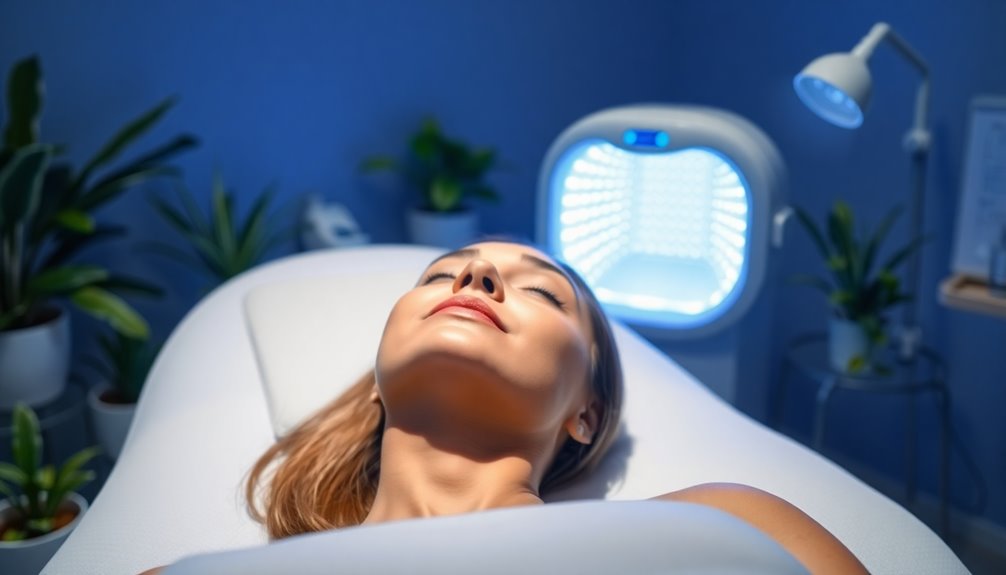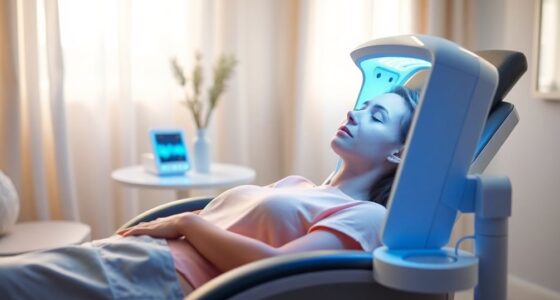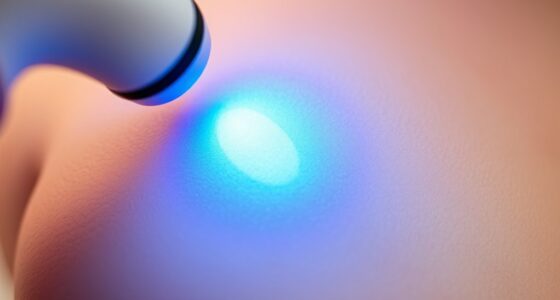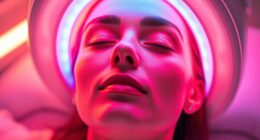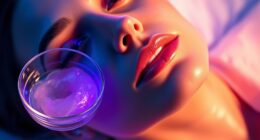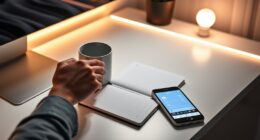Blue light therapy is an effective solution for acne, targeting the bacteria that cause breakouts. By using specific wavelengths, this treatment reduces inflammation and promotes clearer skin. It's non-invasive, painless, and requires no downtime, making it a convenient choice. You can expect a significant improvement in your acne after a few weeks of regular sessions, typically twice a week. While there may be minor side effects like redness or irritation, they're generally mild. To maximize results and safety, consider following a tailored skincare routine. Stick around to discover more about how to make the most of blue light therapy for acne.
Key Takeaways
- Blue light therapy effectively targets acne-causing bacteria, reducing inflammation and leading to fewer blemishes with a 77% improvement rate after five weeks.
- The treatment is FDA-approved for moderate acne vulgaris, ensuring safety and non-invasive application without downtime.
- Typical sessions last 15 minutes and should be done twice a week for optimal results, making it a convenient option.
- Side effects may include mild redness and skin irritation; severe reactions are rare and can be minimized by following dermatologist guidelines.
- Costs vary, with at-home devices being more affordable than professional treatments, and insurance may cover some sessions.
Benefits of Blue Light Therapy
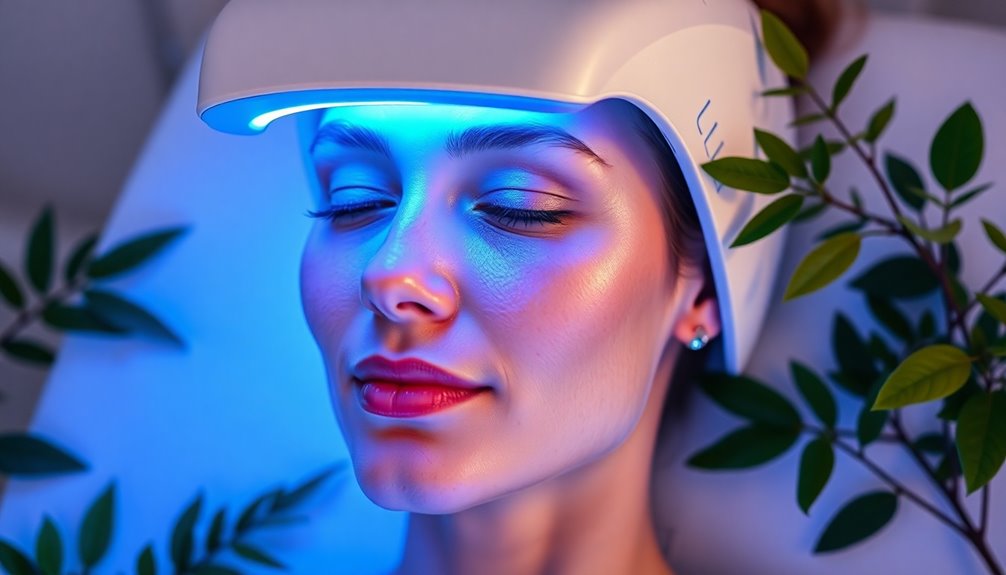
When it comes to tackling acne, blue light therapy offers several compelling benefits that can transform your skincare routine.
First, it effectively reduces acne severity by targeting and destroying the bacteria responsible for breakouts, which helps decrease inflammation and redness. You'll notice fewer blemishes and lesions within weeks of regular treatment, preventing future breakouts and minimizing scarring.
Additionally, blue light therapy enhances your skin's health by eliminating harmful free radicals. It's non-invasive and painless, so you can seamlessly fit it into your lifestyle without downtime. Studies have shown that blue light therapy can lead to a 77% improvement rate in acne lesions after just five weeks of treatment.
Whether you're dealing with acne on your face, back, or shoulders, this treatment can provide a boost to your confidence and overall skin condition, making it an essential addition to your regimen.
How Blue Light Works
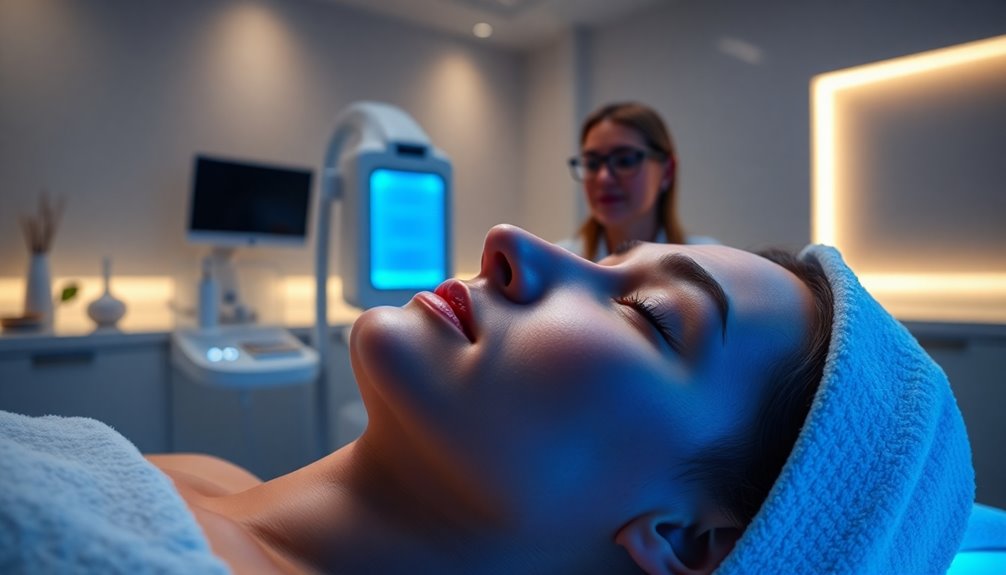
Blue light therapy operates through a precise mechanism that targets acne-causing bacteria effectively.
It focuses on porphyrins released by these bacteria, which absorb light in the blue wavelength range of 405-420 nm. When you expose the skin to this blue light, it leads to the production of reactive oxygen species, causing free radical damage that destroys the Propionibacterium acnes bacteria responsible for acne. This therapy is particularly beneficial because it is FDA-approved for treating moderate acne vulgaris, ensuring its safety and efficacy.
This selective targeting means the therapy doesn't harm surrounding skin, making it a non-invasive treatment option. You typically sit in front of a blue light lamp for about 15 minutes, usually twice a week, to achieve optimal results.
This method has shown to reduce the number of acne lesions significantly.
Safety and Side Effects
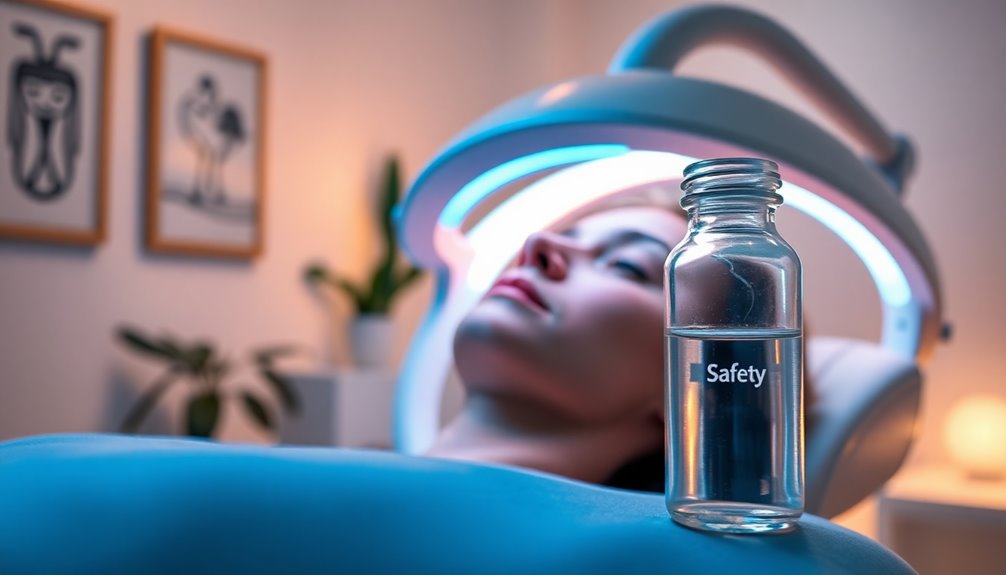
While blue light therapy offers an effective method for treating acne, it's important to consider potential safety concerns and side effects. You might experience mild to moderate redness, skin peeling, or even bruising at the treatment site. Some people report mild pain or irritation, and dry skin can occur, too. Though rare, severe side effects like blistering or burns can happen, especially with overexposure. If you have photosensitivity disorders or are pregnant, it's best to avoid this treatment. Additionally, it is crucial to follow your dermatologist's advice on treatment protocols to ensure safety during the process. Be sure to care for the treated area properly to minimize infection risks. After treatment, avoid direct sunlight and apply sunblock regularly to protect your skin.
Following these precautions can help you enjoy the benefits while reducing risks.
Treatment Options and Costs
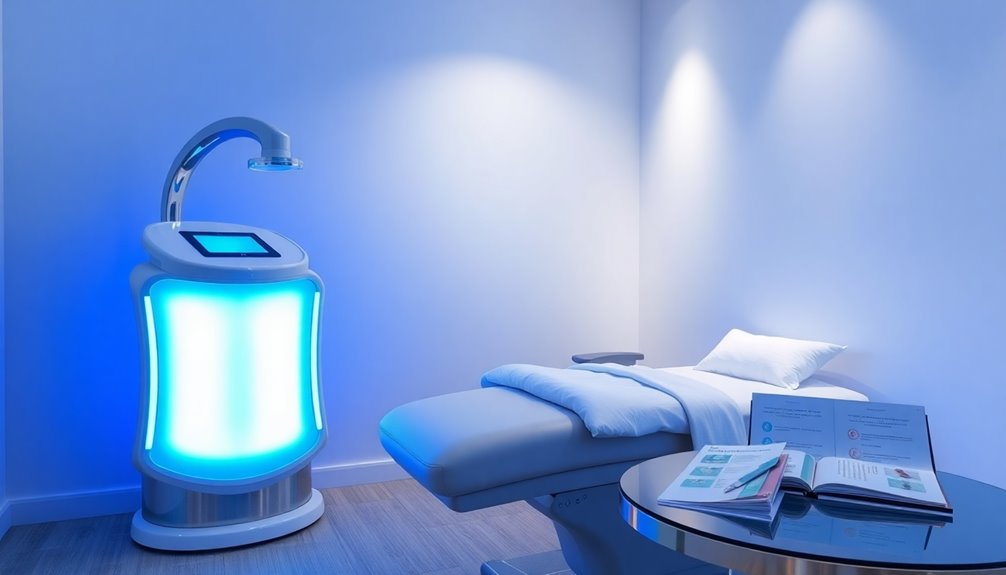
Exploring treatment options for acne can lead you to effective solutions like blue light therapy, which targets acne-causing bacteria. You can choose from various devices, including the Blu-U Blue Light Therapy, which is great for moderate acne. Many clinics offer customized plans that combine blue light therapy with other treatments, such as benzoyl peroxide or topical solutions like aminolevulinic acid. This therapy not only kills acne-causing bacteria but also reduces inflammation associated with acne lesions. Treatment sessions typically last 15 minutes, with sessions recommended twice a week for optimal results. Costs vary widely; at-home devices are generally cheaper than professional treatments, and some insurance plans may cover them. Keep in mind that you might incur additional costs for maintenance sessions and skincare products to sustain your results.
Precautions and Maintenance Tips

After considering various treatment options for acne, it's important to understand the precautions and maintenance tips that will help you maximize the benefits of blue light therapy.
First, apply broad-spectrum sunscreen regularly, especially after treatment, to protect your skin from UV damage. Use a mild, non-abrasive cleanser and avoid harsh products that could irritate your skin. Incorporating regular follow-up appointments with your dermatology provider will also help ensure you achieve the best results from the therapy.
Schedule follow-ups with your dermatology provider to monitor your progress and address concerns. If you're on antibiotics, sensitive to sunlight, or pregnant, consult your provider before proceeding.
During treatment, protect your eyes with goggles. Finally, maintain a gentle cleansing routine, avoid picking at pimples, and keep hydrated to support overall skin health.
Consistent use of the device is key for optimal results.
Frequently Asked Questions
How Long Does Each Blue Light Therapy Session Typically Last?
Each blue light therapy session typically lasts between 10 to 30 minutes, depending on whether you're in-office or using at-home devices.
In-office sessions are usually more intense and last about 15 to 30 minutes, while at-home treatments generally take around 10 to 20 minutes.
It's crucial to follow the manufacturer's guidelines for duration and frequency to ensure effective results without irritating your skin.
Always remember to protect your eyes during these sessions!
Can Blue Light Therapy Be Combined With Other Acne Treatments?
Yes, you can combine blue light therapy with other acne treatments for improved results.
Many people find that pairing it with red light therapy enhances the overall effectiveness, targeting inflammation and bacteria more effectively.
You'll typically undergo multiple sessions, often twice a week, for optimal benefits.
Plus, this combination is generally safe and can be tailored to your specific skin needs, making it a popular choice among acne sufferers.
How Many Sessions Are Generally Needed for Noticeable Results?
You'll typically need about 4 to 6 sessions to notice significant results, with treatments scheduled weekly or bi-weekly.
Some people see initial improvements after just a few sessions, but consistency is crucial for achieving maximum results.
Depending on your skin type and acne severity, the number of sessions may vary.
After the initial phase, maintenance treatments can help sustain your clearer skin long-term, so keep that in mind!
Is Blue Light Therapy Suitable for All Skin Types?
You might be surprised to learn blue light therapy's actually suitable for everyone, regardless of skin type.
It's non-invasive, so you don't need to worry about downtime, making it perfect for your busy life.
Plus, it's FDA-approved for treating acne with minimal side effects.
By targeting acne-causing bacteria and stimulating collagen, it not only helps clear your skin but also improves its overall texture.
What Should I Expect During a Blue Light Therapy Session?
During a blue light therapy session, you'll experience a non-invasive and painless procedure.
You'll need to remove any makeup or skincare products beforehand and wear protective eye goggles.
The session lasts about 15-30 minutes, targeting the acne-causing bacteria in your skin.
You might notice mild redness or swelling afterward, but it typically resolves quickly.
Most importantly, you can go back to your normal activities right after treatment without any downtime.
Conclusion
In the battle against acne, blue light therapy is like a knight shining a beacon of hope in the darkness. It targets the bacteria that cause breakouts, helping you achieve clearer skin. While it’s not a magical cure-all, many people find it an effective ally in their skincare routine. Just like tending to a garden, consistency and care are key. So, embrace this innovative treatment, and you might just watch your skin bloom into a healthier version of itself. Moreover, as you incorporate blue light therapy into your regimen, you’ll likely notice a reduction in inflammation and redness, further enhancing your skin’s appearance. The blue light therapy benefits for acne extend beyond just clearing breakouts; it can also help minimize the occurrence of future blemishes when used regularly. By combining this treatment with a well-rounded skincare routine, you can cultivate a complexion that feels as radiant as it looks.
